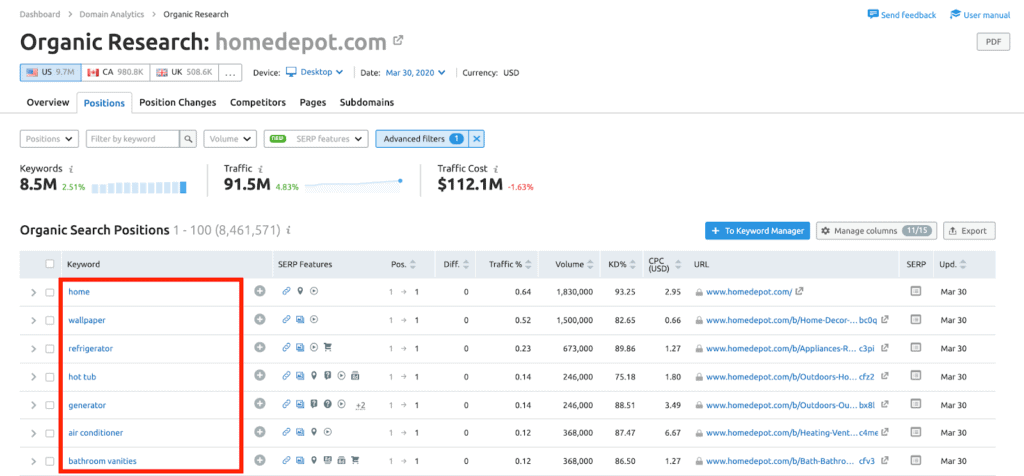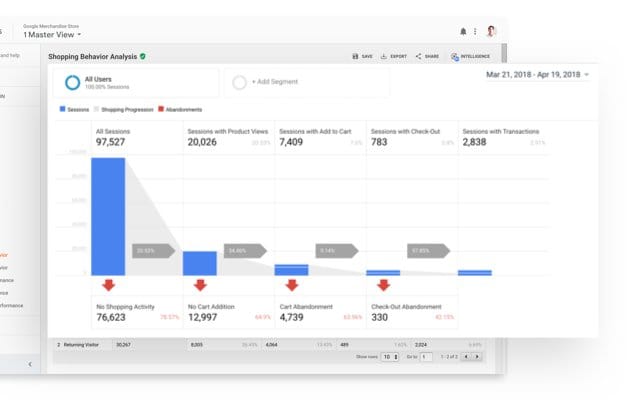Software as a Service, often referred to as SaaS, is booming. Ubersuggest found that the term “SaaS companies” receives approximately 3,600 online searches every month.
This means that now more than ever it’s important for SaaS companies to stand out from the competition, starting with search engine optimization (SEO).
In the post, we will discuss the top SEO strategies your SaaS company can use to increase traffic and brand awareness.
First, some background information:
Why is SEO important for SaaS?
SEO is one of the most effective tools available today.
At its core, SEO works to optimize a website so it can receive high rankings on search engines, and, as a result, increase visibility and gain more web traffic.
SEO derives from the words, habits, and topics real users employ when searching online. By analyzing these, your company can create content that satisfies consumers and performs well on search engines.
By following accepted SEO practices, your SaaS company can instantly raise the quality of your website, while becoming more user-friendly.
In sum, the most significant SEO factors involve:
- Pinpointing what users are searching for online in regard to your SaaS company
- Creating valuable content for your target audience
- Cueing search engines and algorithms with the right prompts and tactics
SEO is key to your SaaS company’s success because the majority of search engine users are most likely to click on one of the top 5 search engine result pages (SERPS).
Today’s consumer puts a lot of trust in search engine results and search engine ranking, so if your page has a high ranking, more users will trust your company.
Ready to increase your web traffic and SaaS brand awareness? Let’s get started.
Step #1: Perform an in-depth technical SEO audit
SEO isn’t motionless and unchanging. It’s a structure with guidelines and processes.
The foundation of that structure is technical SEO.
What is technical SEO?
Technical SEO is independent of content. Instead, it’s related to crawling and indexing—what Google’s bots do in order to determine what pages are high-quality, and therefore which ones show up at the top of the search rankings. Technical SEO relies on keywords (the words users would use to search for) and metadata.
Technical SEO can be the trickiest part of your SEO strategy, which is why many brands hire an agency with SEO expertise to conduct them.
How to run a technical SEO audit
Start by crawling your website with tools such as SEMrush, DeepCrawl, or Google Search Console.

From there, remove any duplicate content, restrict indexation, provide URL parameters, and fix redirects.
It’s also important to review your sitemap and ensure it’s clean, concise, up-to-date, and registered in Google Search Console.
Step #2: Find your most valuable keywords
After tidying up your site’s technical SEO, you’re ready to pinpoint your most valuable keywords. These are the keywords that your target audience often uses in online searches.
It’s worth noting that some keywords are easier to rank for than others. Long-tail keywords, also known as keyword phrases, are easier to rank for because they are more detailed and specific.
Some examples of long-tail keywords are:
- SaaS companies, Austin
- SaaS providers for income tax filing
- B2B SaaS marketing solutions
- SaaS tools for small businesses
- SaaS solutions for the hospitality industry
These keywords apply to a smaller percentage of search engine queries.
On the other hand, general keywords, like “SaaS companies” or “B2B SaaS tools,” are harder to rank for because every other SaaS company, no matter where they’re located, is trying to rank for them, too.

To best approach ranking for valuable keywords, go after the keywords with a substantial amount of volume, but not the highest amount of volume. It’s extremely difficult to rank for the most popular keywords unless you’re a very well-known brand in your field, so for most companies, it makes sense to aim slightly lower. In essence, there is a keyword “sweet spot” that you should aim for.
Test out your keywords
After deciding on a keyword, examine how your competitors are employing it.
Search your keywords online to find:
- If they are included in the domains and URLs
- If they are included in title tags
- The type of content that has the highest ranking (blog posts, videos, etc)
- The types of businesses that have the highest ranking
This research will give you insight on how to match and outperform the competition.
Step #3: Create valuable content around your keywords
Creating valuable content is one of the most important aspects of your site’s SEO.
After identifying your most important keywords, consider the intent behind the internet search.
The more specific the keywords, the easier it will be to understand the consumer’s objectives.
Now, start thinking about how you can create content that will best be of service to your keywords and their intentions.
If “SaaS tools for small businesses” is a popular keyword you’re seeing, for example, you could create a blog post on a topic like, “4 Benefits That Small Businesses Can Reap From SaaS Tools Right Now.”
We’ve said time and time again that keyword research is the bread and butter of content marketing.
It’s how we figure out which topics are trending, timeless, or to be avoided.
By leaning on these keywords, you can create content that will show up on search results.
Step #4: Conceptualize your content
Now you can start conceptualizing your content that will rank for your selected keywords.

Common content types for leveraging SEO include:
- Blog posts
- Articles
- Product pages
- Infographics
- Videos
Think about what types of content your target audience would like to come across. Always try to picture your keywords from the customer’s point of view—by putting yourself in the seat of your client, you can achieve better content conceptualization.
Step #5: Strategize your content
While strategizing, determine how long your content will take to create, and who is in charge of creating it.
Remember, outsourcing your content marketing is always an option.
There’s also another way to go with this: Content refreshing.
A systematic approach to content refreshing will provide valuable insights to any company looking to hold on to hard-earned traffic:
Target Secondary Keywords
The performance of many search articles can be improved simply by deliberately targeting secondary keywords: relevant long-tail keyword variations that don’t warrant a standalone article. In isolation, these keywords rarely generate more than a handful of visitors per month, but in aggregate, they can add hundreds of monthly visits.
By targeting 10 secondary keywords, for example, your traffic can climb from less than 100 to well into the thousands. When you widen the focus of the article beyond the original topic to include more, you’re able to target a suite of relevant secondary keywords—and dramatically increase the search potential.
You can find these keywords through three sources:
- Incidental keyword rankings: These are unintended keywords that currently rank in low positions (page two or beyond).
- Rankings from competitor content: These are relevant keywords that other articles on the same topic already rank for—something which Clearscope can analyze for the top 30 ranking articles for a given keyword.
- Keyword research tools: These are keywords derived from matching terms, related terms, and search suggestions report in tools like Ahrefs.
For this exercise, subject matter expertise (SME) is crucial: You need to evaluate the secondary keywords for relevancy, and the exact relationship between each keyword needs to be understood. But what’s the key to making this process work? Use writers that are dedicated not just to the industry, but to writing for SEO.
Fill Gaps in Your Content
Even if there aren’t keywords to back you up, you still have to remedy gaps in existing content. Gaps can often take one of three forms:
- Missing information: Review your existing content to see if it can surface key information that’s missing from the top-ranking articles. When you do a refresh, it’s an opportunity to make your content more comprehensive and fill in gaps of information that other articles are missing.
- Data and social proof: You should dedicate a portion of each refresh to sourcing new data and incorporating social proof to validate your recommendations—you know, like the real, lived experiences of your customers.
- Stay up-to-date with changing trends: Incorporate relevant trends into older articles, in order to preempt a potential decline in traffic.
These improvements play an indirect role in improving your site’s search performance, and a better viewer experience will equal better on-page engagement—and a greater chance that your visitors will engage with your content in the future.
Keyword volume isn’t perfect as a metric. Keyword research tools often struggle to accurately estimate volume for those long-tail keyword variations, and “zero volume” keywords will often still generate a handful of real-world visits.
And keyword volume isn’t static; keywords may generate visitors in the future, though they have no volume today. (This is called keyword volatility.) When you update content to reflect the changing trends, your content becomes positioned to rank for new keywords as they appear.
You have to use both quality and comprehensiveness as the main determinants when you refresh your strategy—not just keyword volume. In doing so, you’ll be able to rank for keyword opportunities that are often invisible to the keyword research tools you’re using. The tools update content with readers in mind, not search engines, and they have better search performance because of it.
Treat the Refreshed Content as New Content
When you refresh content, you’re aiming primarily to increase organic search traffic. But you can go further by using this “new” content to generate traffic and engagement from other channels.
These extra channels could be:
- Organic social: Use your company’s social media accounts. The engagement creates fuel for future refreshes.
- Owned email: Share the “new” articles through your company’s monthly content roundup emails and/or newsletters.
- Paid social: Use paid ads to promote your updated content.
We know; it’s a process. But it’s all made possible when you achieve those previous steps. When you fill those gaps and expand articles with secondary keywords, your updated articles contain enough new information to warrant extensive re-promotion. You can use the feedback you get from readers (and, let’s face it, potential customers) to highlight trends and get further information to build into your next refresh. Always think ahead!
Content Refreshing Can Be Powerful
When used strategically, content refreshing can become a powerful tool. But you have to treat content refreshing as an ongoing process—and that way, most articles/blogs in your library will likely cycle through.
Most companies end up chasing an endless cycle of new rankings, but that comes at the expense of their older articles which will eventually end up losing traffic entirely. Content refreshing is crucial if you want to grow your search presence.
Step #6: Execute and publish
At this stage, it’s important to remember that in addition to hitting the right keywords, you want your content to be high-quality. Leverage your keywords without sounding robotic.
In terms of publishing, timing matters. While there are some general best practices about the days of the week and times of day that are best to publish—Sunday mornings, as you might guess, are generally less effective—it will take some testing to find out what days and times get you the most views and the best engagement.

Try out a few different options, and keep an eye on your metrics to see what’s working.
Step #7: Promote your content
Your work isn’t done after you hit “publish.” In fact, that’s when your promotional efforts should be going into high gear.
Here’s how to get the most out of your optimized content and create even more opportunities for high search rankings:
- Post your new content on your company’s social media accounts
- Share your content with employees, so they can post on their own social media
- After sharing, actively engage with your customers to increase your content’s air time
- Include social buttons with your new content to allow for easy sharing
These tactics will help your SaaS company site garner more page views, which will help improve your search engine rankings.
Think of it as a mutually beneficial connection: More page views will result in a higher search engine ranking, and vice versa.
Step #8: Analyze
After publication and sharing, it’s valuable to check in on your performance using an analytics tool like Google Analytics.
Again, SEO isn’t static, meaning you can always make improvements, even after a post goes live.

Check to see:
- What keywords your content is ranking for
- If your content is fully optimized
- If your content is truly high-quality
- If you’re gaining visibility
Don’t be afraid to revise and tailor your content. If your chosen keywords are too competitive, go with a less competitive option.
There is an inherent nuance to SEO success, but it’s well worth the time and effort to get it right.
Ready to grab more market share through SEO? Contact us today to get started.




